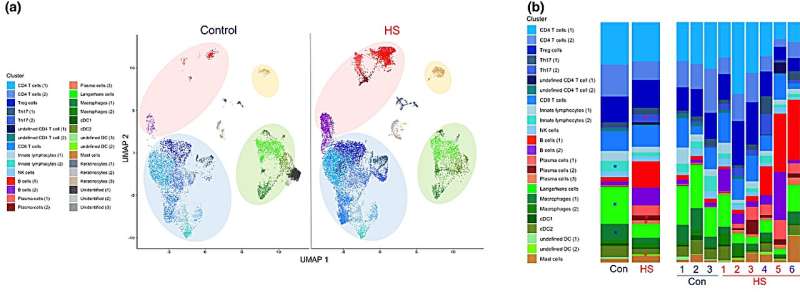This article has been reviewed according to Science X's editorial process and policies. Editors have highlighted the following attributes while ensuring the content's credibility:
fact-checked
peer-reviewed publication
trusted source
proofread
Scientists unearth potential new target for treating debilitating skin disease

A team led by scientists from the Trinity Biomedical Sciences Institute (TBSI) has unearthed the possible target for treating the debilitating skin disease hidradenitis suppurativa (HS), which is a painful, chronic, inflammatory skin condition that can last decades.
Despite affecting up to 1% of the population it is often under-recognized and under-diagnosed. Given its high morbidity, reduced quality of life and poorly understood disease trajectory, there is an unmet need for effective therapeutic options, with new treatments badly needed.
In new research published in the British Journal of Dermatology, led by Dr. Barry Moran and Conor Smith from Trinity's School of Biochemistry and Immunology and Prof. Jean Fletcher from the School of Medicine, the scientists identified significantly increased numbers of proinflammatory immune cells in skin samples collected from HS patients.
Among other immune populations usually infrequent in healthy skin, these included Th17 cells, B cells, plasma cells and neutrophils.
When they analyzed the gene profiles of thousands of these individual cells, they noted that genes and pathways linked with inflammation-associated Th17 cells, cytokines IL-17 and IL-1β, and the inflammation complex known as the NLRP3 inflammasome, were enhanced in HS skin—particularly in samples with a high inflammatory load.
Importantly, with regard to unearthing a potential target for treatment, the scientists then showed that blocking this NLRP3 inflammasome with a small molecule inhibitor significantly reduced the secretion of key inflammatory mediators in HS skin samples.
Dr. Moran said, "Our work provides the first proof of principle that inhibiting the NLRP3 inflammasome reduces inflammation in HS skin and, as such, we have unearthed a potential target for treating this debilitating condition. Ultimately, we now have a rationale for targeting the inflammasome in HS using small molecule inhibitors, which are currently in trials for other indications."
Conor Smith, co-author and Ph.D. candidate at Trinity, commented, "This was a real collaborative effort between our clinical partners in St. Vincent's University Hospital, particularly Prof Brian Kirby and his team who recruited patients and contributed invaluable clinical input, and our team in TBSI providing the scientific and technical expertise to make this study successful.
"Much of the research that we do here in the Fletcher lab is focused on improving our understanding of this debilitating disease and identifying potential new therapeutic options. We hope that this study can prompt further clinical investigations into the suitability of targeting the NLRP3 inflammasome to treat HS."
Professor Fletcher added, "These small molecule inhibitors targeting the NLRP3 inflammasome may offer new treatment avenues beyond the biological treatments currently (or likely to be) approved in treating HS."
More information: Barry Moran et al, Targeting the NLRP3 inflammasome reduces inflammation in hidradenitis suppurativa skin, British Journal of Dermatology (2023). DOI: 10.1093/bjd/ljad184


















